A Step-by-Step Guide to Creating Characters Your Audience will Love
Movies and TV shows attract viewers with the premise. But they endure because of characters. Here's how to create compelling ones.
This is a free edition of my Weekly Email Newsletter! Every week I do a deep dive on an aspect of the business of screenwriting from a (former) literary manager’s perspective.
Subscribe, so you never miss a post.
Creating compelling characters is a fundamental part of the screenwriting process.
When you look at the iconic characters that people have loved, it feels intimidating to task yourself with constructing someone that original, that deep, that real. As a literary manager, I have read too many scripts with characters that are confusing and all over the place.
Or worse, I’ll read a script in which the writer doesn’t include enough information about their characters.
In either case, I find myself asking “What is this character’s deal?”
Meaning I want to know why we care about them. And what, specifically, is it that we should care about.
If readers aren’t falling in love with your characters, it’s time to dig deeper.
I have spent the past ten years helping elevate the characters in writers’ scripts
I have also read tons of theory and used it to analyze the scripts that I love. Today I have outlined a step-by-step, repeatable process that you can apply to your own script. This will work whether you’re just getting started or if you’re getting the note “We just didn’t connect with the characters.”
You can do this exercise for your protagonist first, but you don’t have to!
Start with the character you are most excited about or interested in. For best results, don’t stop there. Go through the full set of steps for every single character we meet.
Yes, even for the supporting characters, the best friend, and anyone who you think is insignificant compared to the main players of your story. I know that this sounds like a lot of work.
It is.
But it’s worth taking the time to do this properly.
The unique depth and personality traits of the characters in your story are what will make or break your script. Skip any of these steps, and readers will notice. You cannot get away with being lazy or rushing through this. You cannot overshadow weak supporting characters with extra strong main ones.
It will be more rewarding for you and for your audience if you do this process thoroughly.
And it will make writing the draft much easier when you know the players you have in your tool belt to use in whatever scene you are writing that day.
Step #1: Know who your character is on an external level.
What role does this person serve in your story?
Do they satisfy an archetype?
This isn’t required but is something to think about:
Hero/Protagonist
Best Friend/Sidekick/Ally
Villain/Antagonist/Opposition/Rival
Love Interest
Mentor
How does this person add tension to your plot? How will they make the other characters’ lives miserable?
And most importantly, why will we love them? Or love spending time with them?
This is just the starting point. Don’t worry, we’re going to go much deeper with all of these. But step one is to sketch out what you DO know about your character.
EXAMPLES:

Shrek - click here for access to the original script.
Hero/Protagonist
Shrek is not your typical hero. Unlike the handsome knight who usually rescues the princess in fairy tale stories, he is ugly, gross, curmudgeonly, and unwilling to play by other people’s rules. His life of independence has made him used to doing everything his way, and he doesn’t like working with other people.
He will make the other characters’ lives miserable by scaring them off or being mean to them when that doesn’t work. He will refuse to do things the “polite” way and instead go about accomplishing his goals efficiently.
We will love him because of his cheeky Scottish accent, his relatable sarcasm, and the ways he pokes holes in fairy tale tropes that aren’t actually relevant to our own lived experiences. He has creative fighting tactics and problem solving strategies.
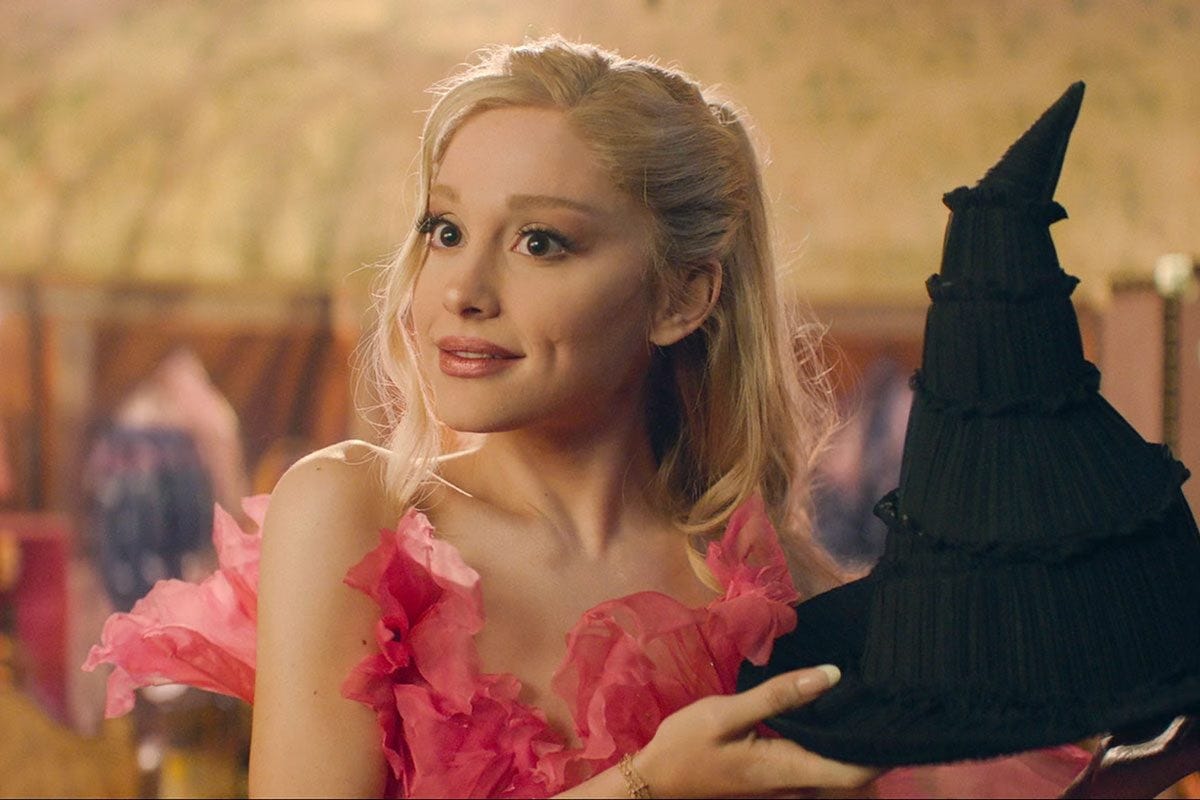
Galinda (Wicked) - click here for access to the original script.
Best Friend/Antagonist/Co-Protagonist/Love Interest1
Galinda adds tension to the plot by being an unreliable narrator trying to balance her own high status in society with the loyalty she feels she owes her friend. She spends most of the story trying to learn sorcery (which she is bad at), seducing the most popular boy in school (which she is good at), and trying to maintain her own self-perception as a good person while also amassing popularity (which is impossible, yet she somehow does it).
She will make the main character’s life miserable by being roommates with her, taking up space, being annoyingly perfect, and insisting that everything is done her way. There will also be a lot of pink.
We will love her because she is beautiful in an infuriating yet aspirational way. She is silly in an endearing way, and her air-headedness seems to come from a genuinely good place. Lest she be too unrealistically perfect, the fact that she actually can’t do magic is fun to watch because of the gap between her self-perception and her actual abilities. We can’t count out her angelic singing voice, which counts as an external hook here.
Step #2: Know who your character is on an internal level.
Who is your character on this inside?
The true nature of someone’s personality isn’t always something they can recognize or articulate. Yet it’s still there, and it dictates their every action. Who your character is on this inside is inextricably tied to the theme of your movie or TV show. The lesson your character needs to learn is the lesson the writer wants your audience to learn.
So you’re going to want to know about their deepest, darkest fears and how those fears made them the person that they are today.
Again, don’t worry if you don’t know everything about their psychology. We’ll dive deeper in a later step. For now, just list out what you do know.
If you don’t yet know anything about this person’s internal layer, look at the external characteristics you have already decided on.
Ask yourself, “What would make a person act like that?”
EXAMPLES:
Shrek
Shrek understands that he repels people because he is physically ugly.
He wears his repulsiveness as an armor, seemingly impervious to the repetitive insults he receives.
But internally, there’s a deep insecurity here. He has convinced himself that he’s okay with his status quo so he doesn’t have to admit how lonely he is.
His fear is that he is unworthy of any kind of love—especially romantic love.
Galinda
Galinda is conventionally attractive, wealthy, and an only child.
She has grown up being treated like a princess, and she leans wholeheartedly into all the stereotypes that come with this.
But internally, she is terrified that it is a facade. She wants more than anything to be a true sorcerer, someone who can wield powerful magic. Because her whole life she has been told that she is special, she wants this to be true when it comes to her competence, not just her outward appearance.
Her deepest fear is that she’s a fraud and that the only reason people love her is because they have fallen for the illusion that she puts up.
These characters are both very strong and clear.
Part of this comes from the fact that they appear in big, high-concept, four-quadrant feature films. Such movies lean heavily on archetype and simplicity, which makes them great tools to learn from. When you’re first studying story structure, I recommend learning from animated family movies and superhero films.
But these tools also apply to smaller, more nuanced characters in every genre.
So for variety, I’ll cycle through some other examples in every step as well.
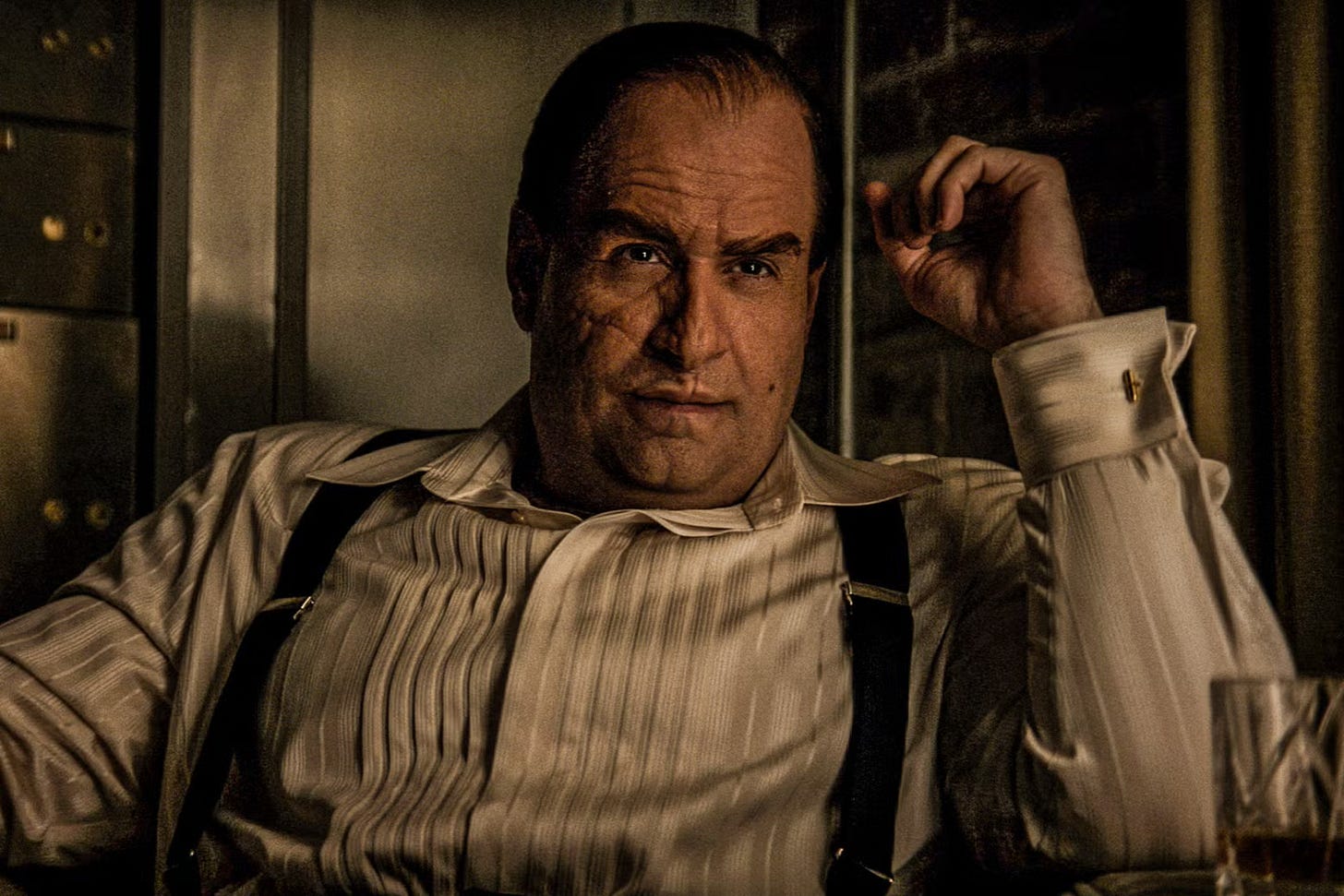
Oswald Cobb (The Penguin) - click here for an in-depth character breakdown.
Oz is a clubfooted, ruthless gangster who grew up in poverty in Gotham.
He was raised by his mother to believe that despite the physical and societal conditions working against him, he still has what it takes to become the most powerful man in the city. He just has to outsmart everyone around him and be unafraid to violently dispose of anyone in his path.
Internally, he craves respect. He wants to be a powerful gangster, yes, but in doing so, he longs to be known as the man who takes care of his community and gives back to the little people he rules over.
Raised by a single mother, her love and attention is the most important thing in the world to him. He is terrified of being unable to take care of her.
His mother relies on his ability to protect and provide for her, and his greatest fear is disappointing her.
Ani (Anora) - click here for access to the original script.
Ani is a young, attractive, working class stripper in New Jersey.
She lives with her sister as her roommate, and she is good at her job. She spends her evenings in transactional relationships with men and blowing off steam about her experiences with her girlfriends from work.
Internally, she believes that her body and her dancing are her best and only source of value. She doesn’t see any way out of her current lifestyle, and the beginning of the movie she has convinced herself and everyone around her that she’s happy with this state of things.
But like any American, there is a secret, dormant belief that she is destined something more.
Her greatest fear is that this is impossible. That her current economic status is all that she is and all that she will ever be.
Step #3: Determine the Inciting Incident.
It can be helpful to back into the Why Now of your story.
Your character is going about their everyday life, when BAM! Your story happens. Knowing why this incident is so earth-shattering to them will help you learn more about their personality. Ideally, the Inciting Incident should be the worst posspible thing that this character could ever expect to suffer (in their minds)2.
This is emotionally the worst thing ever, and it is specific to your character. It doesn’t need to be objectively the worst thing a person could possibly experience. The event you choose here will depend on the genre and tone of your story.
Anything can be “the worst” for someone. You just need to give us the context we need to understand to believe why it is the worst thing possible for this person.
Inciting Incidents are causally linked to the rest of your story, like a domino effect.
If you can take a scene or event out of your script and the rest of your movie makes perfect sense, you should immediately delete (or change) that scene.
A well-structured script is like a house of cards. You can’t remove one piece without the whole thing coming apart. If this isn’t the case, it means your script isn’t as efficient as it could be.
Movies are expensive, and an audience’s attention is difficult to capture and even harder to retain. Make the most out of your story by operating at maximum efficiency. That will keep these costs as low as possible.
The inciting incident tells us what is most important to the character. It also sets their stakes into motion. The stakes are what will happen if they don’t achieve their goal.
It’s a math equation.
Pick the worst possible situation for this character and the worst character possible for this situation.
EXAMPLES:
Shrek’s Inciting Incident is when his swamp is suddenly overrun with fairy tale creatures seeking refuge. This is the worst thing in the world to him because he values his isolation and privacy more than anything else.
Galinda’s Inciting Incident is when Madam Morrible assigns Elphaba as her roommate. This is the worst thing in the world to her because she has never experienced not getting her way about something before.

Tony Stark (Iron Man) - click here for access to the original script.
Tony’s Inciting Incident is when he is kidnapped by terrorists3 while on a PR trip to the Middle East. This is the worst thing in the world for him because up until now he has lived a comfortable life of power and luxury. He is used to being in control and has never been vulnerable or lacked resources.
Diane Chambers (Cheers) - click here for access to the original script.
Diane’s Inciting Incident is when she meets Sam Malone. This is the worst thing in the world for her because unlike the men she is used to, he is working class, irreverent, unintellectual, and unafraid of hurting her feelings.
Step #4: Know your character’s goal.
Wait a second. I thought this was a character-building exercise.
Why are we spending so much time on plot?
Because today’s secret lesson is that the two of them are inextricably linked. Your plot is your character. Your character determines your plot.
To ensure your character and plot are sufficiently linked, try this stress test:
Pick your favorite character from a different movie.
Substitute them into your script instead of your current main character.
Can the plot of your movie stay exactly the same?
If so, your plot is too arbitrary. You need to link it to your character’s journey, or the whole experience is going to be meaningless to your reader.
A strong story is one that is only happening because of the specific person that it is happening to.
A normal, well-adjusted person would have taken a healthy action in response to your inciting incident. Like go to therapy or develop a creative outlet as a hobby.
But not your character. That’s what makes this fun.
A different character with a different internal wound, flaw, and weakness decides on a problematic (and therefore entertaining) goal, tactic and strategy.
What makes your movie unique is your character’s uniquely flawed approach to problem solving. Your biggest plot moments are also your biggest character moments. The character moments are what give your story its meaning. What the character chooses to do in the significant moments of your script reveals who they are at that part of the story.
Every single moment in everything you write has the potential to perfectly align character, plot, and theme. And you should endeavor to live up to this standard.
That’s why I never talk about whether character or plot is more important in a script.
It drives me crazy when people pitch an idea as “character-driven” or “plot-driven.” If you’re doing it right, then your story is both! Always. The whole time. World, setting, and time period are not enough on their own to keep your audience’s interest.
Your audience is invested in your script because of the character at the center of it and the adventure that this character is going through. Whether your story is big or small, comedy or horror, grounded or high concept, it needs to be rooted equally in character and plot to work.4
Your character’s goal tells us what is important to them.
It tells us what they think they need to be happy. Whether they change their mind about this later in the movie is up to you. Whether they achieve or fail their goal is up to you. You get to determine the ending based on what you want your audience’s emotional takeaway from the story to be.
But at the very beginning, your character should have a strong opinion about what they think they want.
This goal is likely the basis of the Central Dramatic Question of your movie or TV series.
It is external and specific. Meaning, we will definitively know by the end of the film whether they have achieved it.
To test whether your character’s goal is truly external, ask yourself:
What would it look like (in your character’s mind) for them to actually achieve that goal in the easiest, best case scenario way possible?
For extra credit, actually write out that scene in Final Draft. You don’t have to include it in your screenplay. Your character will probably ultimately succeed or fail at their goal in an ending that’s different than how they originally pictured. But it’s helpful to have a vision for what they hope it will look like.
Another way to ensure your character’s goal is inextricably tied to their internal arc is to ask yourself:
Why can’t they achieve this at the beginning of the movie?
They are not yet equipped to.
They are too flawed and/or too weak. They don’t have the right mindset. They lack the physical tools, allies, and capabilities they need to attain their desire. More importantly, they don’t have the emotional tools they need.
The events of the movie (or TV series) will force them to change their beliefs about themselves.
This is the INTERNAL NEED. The lesson of the story. The whole reason we’re here.
Once you know the situation that arises because of the Inciting Incident, ask yourself:
How equipped is your character to handle the concept of your movie?
Can you make them even less equipped to handle it?
EXAMPLES
Shrek’s goal is to rescue Princess Fiona from the dragon and deliver her to Lord Farquaad.
This is important to him because once he accomplishes it, the leader of the kingdom will remove all the fairy tale creatures from his swamp.
He is best equipped for the job because he is strong, terrifying, creative, and unafraid of physical violence.
He is the worst person for the job because he has no idea how to talk to a lady—let alone a princess.
His internal need is to be vulnerable with another person and admit his true desire to be loved.
Galinda’s goal is to become a sorceress.
This is important to her because she already has everything else that a privileged girl in her position could want. But she wants to go beyond the things she has been handed. She wants to accomplish something truly admirable: An ability to wield magic.
She is the best equipped person for this because she is persistent, competent, and persuasive. She believes that greatness is determined by popularity and politics, and she is excellent at leveraging both of these things to get what she wants.
She is the worst person for the job because she doesn’t have an ounce of magical talent in her body. She is also so unaccustomed to challenges that she doesn’t know how to overcome any obstacles. She literally faints with shock when something doesn’t go her way.
Her internal need is to learn that greatness doesn’t come from magic. It comes from being willing to sacrifice your own needs for the sake of someone you care about.
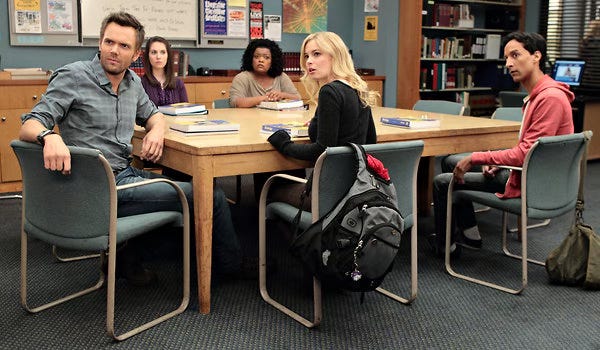
Jeff Winger (Community) - click here for access to the original script.
Jeff’s series goal is to get his undergraduate degree from community college while doing as little studying as humanly possible.
He is the best equipped person for this because he is handsome, charming, and can convince anyone to do anything.
He is the worst person for this because he has nothing but disdain for anyone who is dumb or sad enough to be stuck in community college.
Jeff’s pilot goal is to start a fake Spanish study group to convince Britta to go on a date with him.
He is the best equipped person for this because he is handsome, charming, and can convince anyone to do anything.
He is the least equipped person to do this because Britta values honesty more than anything else, and Jeff is almost pathologically incapable of being honest. Also, he doesn’t know any Spanish.
His internal need is to learn that life isn’t about external status, it’s about developing empathy for the friends who depend on you.
Step #5: Go even deeper.
By now you should have a pretty strong sense of who your character is.
But that’s not enough. It’s time to go deeper.
I call this “taking your character to therapy.” You might know their strengths, weaknesses, and insecurities. But do you know where these came from and how they manifest outwardly in different ways?
Conduct an interview with your character by asking them probing questions.
Write this down in a journal in the form of a back-and-forth dialogue. Don’t let them off the hook if they try to give you a shallow answer or avoid the question. Keep asking “why?” until you hit emotional bedrock.
Here are some jumping off point questions to get you started:
What is your character’s flawed worldview?
What do they think would make them happy?
What do they think is wrong with the world?
What is their defining childhood memory?
How do they view each of their parents? Their siblings? How do they think each of these people feels about them in return?
What is their greatest fear?
What is their biggest insecurity?
How has this insecurity manifested as overcompensation?
What are they good at? What are they so good at that they’ve come to rely on this skill as a fallback?
What do they look for in a friend?
What is their worst nightmare?
You don’t have to include any of this in your script.
In fact, you probably shouldn’t. It could be information overload for your audience. But you need to know it.
Why?
Because having a strong sense of who your character is beyond your script will make them feel like a real person. It will allow interesting quirks and personality traits to bubble up to the surface. It will inspire jokes, off-handed comments, and lore.
If you never include any of this information in the pages of your story, it will still be there, simmering under the surface.
But if you skip this exercise, your audience will be able to tell. The character will feel flat, and readers won’t believe that they are a real person with thoughts, feelings, and emotions of their own.
The character will simply feel like a prop.
Step #6: List your character’s flaws.
Storytelling operates in paradoxes, especially when it comes to comedy.
Your character should be the LEAST equipped to achieve the goal that they have. They should simultaneously be the ONLY person who can do it.
How one character be both of these things at the same time??
Do not fear. I have the answer.
The next couple of steps are pulled from my favorite book about building characters:
The Comic Toolbox by John Vorhaus
I highly recommend it for anyone interested in storytelling, not just comedy writers. But it is especially helpful for writers interested in specific, actionable tactics and exercises that will level up their joke writing.
A character’s strength comes from their flaws.
A flaw makes a character fun to watch.
It also shows us why they need to go through the pain of the story. It tells us why they “deserve” to have these things happen to them. And a story is most appealing to an audience when the character brings it upon themselves.
A flaw can be a positive aspect that’s taken too far (i.e. Elle Woods is too kind to fit in with the students at Harvard Law School in Legally Blonde).
The character’s flaw comes from their internal flawed worldview and internalized lie.
There is a gap between where your character is and where they want to be. There is also a gap between who they are/what they’re capable of and who they think they are/what they think they are capable of.
Flaws are externalized personality traits that we can watch on screen. When we see characters act out their flaws, we see them act out their true nature.
And you don’t need to stop at just one!
A memorable character is an extremely flawed one. The more the better. Pile them on.
EXAMPLES
Shrek’s flaws include:
ugly
green
rude
smells bad
breath stinks
mean
offensive
scary
poor manners
selfish
gassy
vulgar
Galinda’s flaws include:
superficial
selfish
spoiled
blonde5
manipulative
incompetent
entitled
ditzy
materialistic
childish
mean
hypocritical
self-indulgent
condescending
attention-seeking
But flaws are only half the equation. Once you lock in this ingredient, there’s another crucial component to add, or the recipe won’t work.
Step #7: List your character’s Humanity.
This is a concept articulated by Vorhaus in his book.
“Humanity” is the opposite of flaw. It’s a character’s positive qualities or their strengths. Put simply, these traits are the reason we root for a character. The worst you make some aspects of a character, the better you must make others.
Examples of humanity include:
loyalty to family
always sticks up for the little guy
resourcefulness
politeness
love of learning
sense of fairness
self-awareness
impeccable taste
always gives good advice
inspiring
optimistic
good at their job
wise
intelligent
strong
EXAMPLES
Shrek’s humanity includes:
good natured
sense of humor
doesn’t take himself too seriously
humble
happy
content
disciplined
confident
resourceful
creative
courageous
strong
secure
Galinda’s humanity includes:
beautiful
charming
kind
empathetic
positive
bubbly
loving
confident
innocent
driven
fashionable
popular
angelic singing voice
Wait a second, aren’t some of these just the positive versions of the flaws we mentioned earlier?
Well, yes. That’s the idea.
The very traits that make a character worth rooting for are parts of them that lead to their downfall. The flaws are their “difference” from us (“that could never be me”), which allow us to enjoy the story. And their humanity is where we see ourselves, which allows us to empathize with them in the story.
Flaws and humanity can be opposite sides of the same coin.
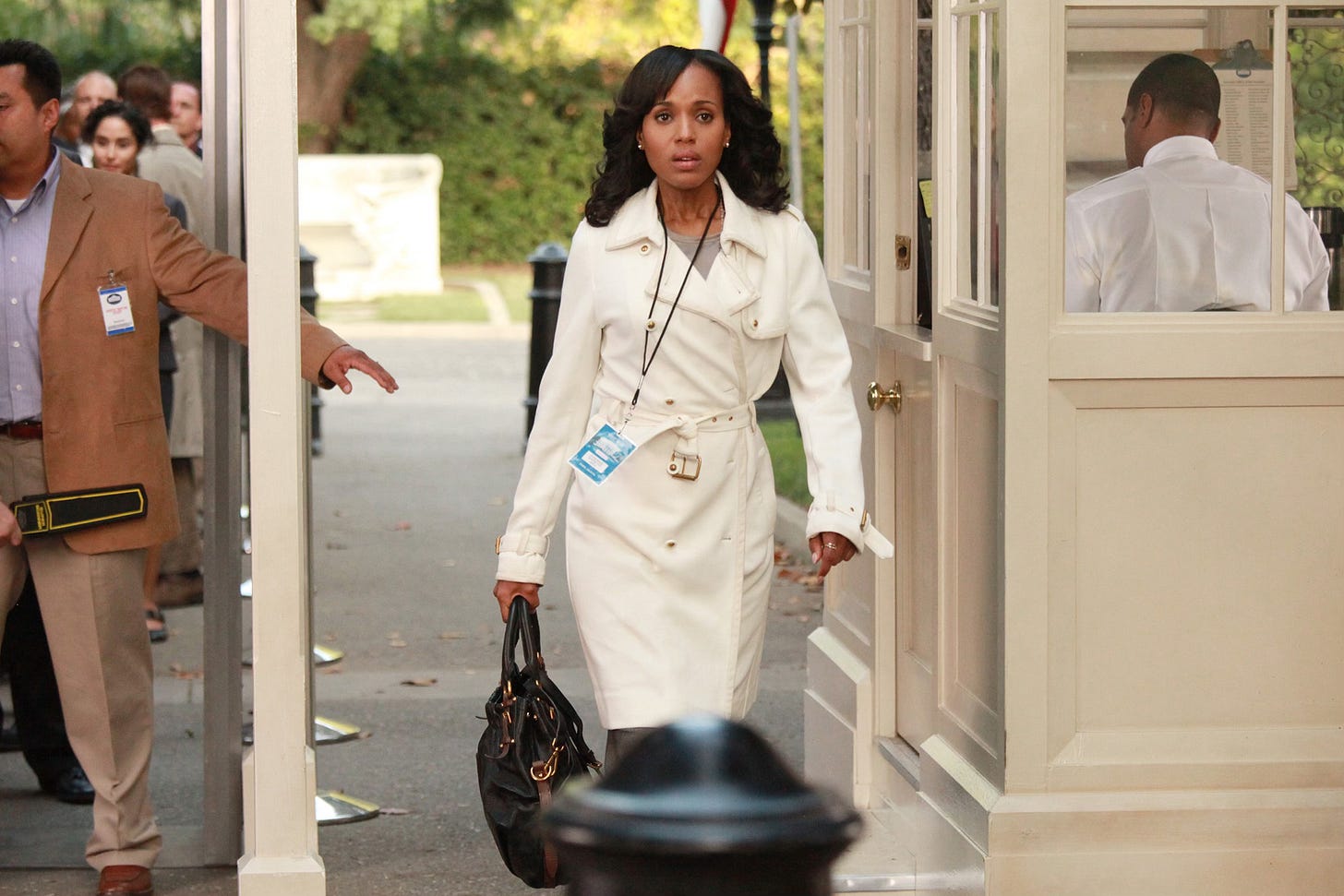
For example, in Scandal, Olivia Pope’s ruthlessness is a humanity that makes her fun to root for. But on many occasions, it manifests as heartlessness, which is her flaw.
On the other hand, sometimes, it’s the clash between flaw and humanity that creates a truly memorable character:
For example, in The Great, Peter’s flaw is his tendency to commit brutal acts of violence with genuine indifference. Versus one of his humanities is a passionate appreciation for delicious food.
I particularly enjoy the iconic example from Vorhaus’ book:
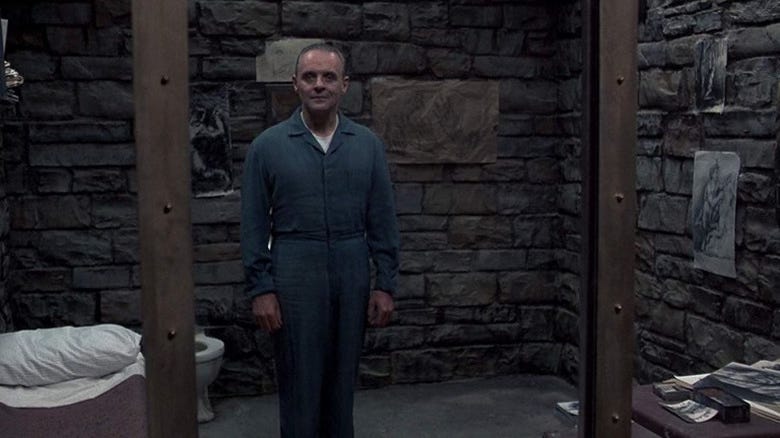
Hannibal Lecter’s strong comic perspective is “People are food.”
His flaws include arrogance, malevolence, psychotic behavior, no self-awareness, immorality, amorality, overwhelming evil, and really bad eating habits. He probably does not floss.
To be a comic character, he’ll need a mountain of humanity to counterbalance his flaws. His positive qualities include intelligence, urbanity, poise, wit, good manners, loyalty to his friends, a sense of fair play, self-confidence, and an incredibly strong will to win: He’ll stop at nothing to eat your face.
Even as we abhor his flaws, his humanity makes us like him and want him to win.
To make Hannibal Lecter work on a comic level, it was necessary to first make him disgusting, make us revile him, and then pile on the humanity to counteract our revulsion.
It’s almost physics: For every flaw, there is an equal and opposite humanity. The worse you make some aspects of a comic character, the better you must make others.
And how fun is he to watch?
Step #8: Exaggerate
You don’t get into the annals of “favorite character of all time” by being subtle.
We love our favorite movies and TV shows because they are larger than life. They take fundamental truths we understand about our own experiences. Then they ratchet them up to eleven.
Once you know your character’s personality traits, push them to the extreme.
Shrek isn’t just gross, his farts kill the fish in the pond. And then he eats them.
Galinda isn’t just extra, she floats down from the sky in a pink bubble while singing operatically.

James Bond isn’t just a competent, super suave spy. He can seduce any woman and complete any mission, thwart any bad guy, and look great while doing it.
Captain Jack Sparrow isn’t just a drunk. He literally does not walk straight during a single moment in the entire Pirates of the Caribbean franchise.
This doesn’t apply only to box office hits.
Nathan for You follows a deadpan Canadian comedian who helps re-vamp struggling businesses. He isn’t just socially awkward. He is so socially awkward that you can’t even understand how people can hold a conversation with him.
Amy Lau in Beef isn’t just a privileged housewife struggling with existential dread.
She lives in the most impersonal, most gorgeous house you can imagine, she drives the stereotypical luxury vehicle befitting her station, and her aspirations are even exactly what you would expect from someone of her class: selling her home design company to a billionaire franchise. And she isn’t dealing with a normal amount of existential dread; she is on the verge of a nervous breakdown from it.
Cassie in Promising Young Woman isn’t just suffering from arrested development in the aftermath of her best friend’s death.
She has literally reverted to the aesthetics of a young girl: pigtails, a scrunchie-bound diary, and her signature nails each painted a different color.
Once you know who your person is, push them to the extreme.
You’ll have fun with it. And that’s what will make them memorable for your reader.
Step #9: Learn your character’s voice.
Structural notes are relatively easy to satisfy.
When your reader doesn’t understand your inciting incident, goal or stakes, you can refine the dialogue to clarify them. If you’re missing an important structural component, adding it in is like solving a puzzle. There is a right answer, you just have to figure it out.
But when the note is, “All your characters sound the same when they talk,” it can be really hard to fix this one.
Writing distinct voices is a much more difficult skill to master than getting a handle on story structure. This is because it’s more intangible and intuitive. Actors, poets, and playwrights tend to have the advantage here.
But it is still a learnable practice.
If you have trouble creating distinct character voices, the first step is to stop listening to podcasts and music when you’re out in public. Make a habit of eavesdropping on the way people talk. If you can do this without being noticed, write down specific phrases or quirks that grab your attention.
Then do a little journaling about what you assume this person is like, based on what you overheard.
It’s time to start training your ear. Make this a daily practice.
When it comes to the character in your script, try the following exercises:
Set a timer and journal as your character. Don’t worry about whether this will appear in your screenplay. Just sit down and be them. Write their diary entry for the day in the first person.
Go shopping for an outfit that they would wear. Dress up in this costume and then journal as them.
Go to a location they frequent. If you can, sit in this spot and journal as them in this place.
Write monologues in their voice. Maybe you’ll use one in your script, maybe you won’t. What matters is that you’re learning how they talk, how they feel, and how they tend to make their points.
Think about the linguistic tics you can give them. What are their filler words? Do they have any bad speaking habits or tendencies that they fall back on when they get nervous?
What are their favorite words? (i.e. Abed in Community saying “Cool, cool cool.”)
What are their pet peeves? What really sets them off? What would they rant about if given the opportunity? What conversation topics get them really going? What could they passionately speak on for hours?
How do they show their passion for a subject? Does it involve a change in volume? Body language?
How does their sense of humor manifest in interactions with others?
Where did they grow up?
How confident are they when they talk?
How do they react when they’re embarrassed? Hurt? Mad? Turned on? Grieving? Stressed? Belittled? Jealous? (add your own emotions to this list)
Watch movies, then read their corresponding scripts.
It is so useful to read a screenplay and seeing how that writer was able to capture the voice as you heard it in the final product.
Switch up the order in which you do this: Read the script for a movie you’ve never seen. Then watch it. Are the character’s voices the same as how you heard them in your head?
Why or why not?
Step #10: Write the introductory moment.
This article is getting long. So let me know in the comments if you want a separate deep dive on the anatomy of a character’s introductory scene.
I’ll give a general overview here:
Every character, by definition, has a moment where the audience meets them for the first time. What we see in this moment is so important because it sets the tone for the rest of our relationship with the character.
I’m not talking about your character description on the page.
I’m talking about the fun part:
How do you introduce this character in a way that tells us everything you learned in steps 1-9 here, just based on what they are doing and/or saying in the exact moment we first meet them?
That’s a lot of information to squeeze into just a few beats, I know.
How can you possibly hope to deliver it?
There are two types of exposition:
Type #1: Intellectual
Intellectual exposition is words being told to us. The “telling” us of the information. This delivery method is often boring, but it doesn’t have to be.
Type #2: Visceral
Visceral exposition is when we experience this information alongside the character, visually and emotionally, through the actions playing out on screen.
While intellectual exposition is great for clarifying information so your audience isn’t confused, visceral exposition is great for making sure that this information hits the audience right in the heart. Great visceral exposition sticks with us for the rest of our lives. It’s the “showing” of the information.
I am sure you’ve heard the advice, “Show Don’t Tell.” But you actually need to do both.
Telling us gives us clarity so we’re not confused.
Showing us makes us remember it and care about it.
When you’re writing your character’s introductory moment, think about how all of this is going to play out on screen. Include as many details as possible.
What is the character doing when we first meet them?
What are they saying when we first meet them?
Do we meet them as the main character? Or are we seeing them through the eyes of someone else in your script?
You do also need a character description .
The art of writing character descriptions could be its own separate deep dive as well.
But here are the basics:
CHARACTER NAME (age) description.
Keep the description as visual as possible. You don’t want your reader to have more information than someone watching the movie on screen will have about this person. Include elements of their personality that an actor can portray.
What other visual details (dress, accessories, posture, mood) can you include?
Brevity and efficiency are key here.
Don’t get bogged down with too much information in the character’s description. It will slow down the read, and your reader’s experience is the most important thing for your script at this stage in its development process. Tom Vaughan gets into more advice on this here.
Oh and one more thing:
Please don’t be mean.
In my decade of experience in entertainment, I have worked and met with many actors. They are human beings. Keep in mind that when you write the character description, “CHERYL (50’s), fat, ugly, long past her prime,” and your movie ends up getting made, some poor actress is going to receive this breakdown from her agent, look at it, and go, “Wow. This is the role they thought was perfect for me. Thanks.”
There is no reason to describe your characters in an objectively judgmental way.
After doing today’s exercise, you should know so much about the character that you have something more interesting to say than whether they are hot or not.
Step #11: Use the Law of Opposites.
You created a character.
You gave them a flawed worldview.
Now it’s time to seek the diametric opposite of that perspective. Assign that opposite to a second character. Throw them into your movie (or TV show, episode, or scene), sit back, and watch the fun.
If you properly leverage character geometry here, you won’t need to struggle to come up with story or scene ideas.
The characters will come into entertaining conflict with one another no matter where they are or what they are trying to accomplish.
Can you do it with a third character? Who would be the opposite of BOTH of them?
Keep going until you have rounded out your whole ensemble.
Step #12: Rinse and Repeat
You can go through the previous steps in any order you’d like.
Once you work through them, go back to the beginning and see what has changed. Do you need to add or modify any previous answers now that you know more about your characters? Keep doing this until you can throw your character into any room and know exactly why their reaction will be so riveting to watch.
For EXTRA CREDIT, add these questions to the Weekly Analysis you are completing for a move or TV show and its script.
Start to notice how other writers have created the characters that are all around you.
Characters aren’t just in movies and TV shows. Once you understand the matrix, you will notice the Flawed Worldview + Flaw + Humanity + Exaggeration in:
Stand-up comedians
Celebrities with vividly specific personas
Musicians
Public Figures
Even Politicians
Who is your favorite character in film or TV?
What is their flawed worldview? What are their internal and external arcs? What are their flaws and their humanities, and how are those exaggerated in your experience of the story?
Let me know in the comments!
Then take this exercise and go apply it to a character in your own Work in Progress.
I’m not queer-shipping this. Love doesn’t need to mean romantic love. It can be friendship love. Structurally, Elphaba and Galinda’s relationship is a rom-com. There is nothing necessarily wrong with reading a bisexual subtext into their interactions, but I do recommend not making a habit out of projecting character dynamics onto a story that are not actually present in the text. But I’m not here to rain on anyone’s parade. Have fun with it. It’s not that serious :)
This is of course not always the case. Sometimes the Inciting Incident is a positive opportunity. Or it could be a seemingly positive event that turns negative in a “be careful what you wish for” sense.
The politics of this movie have aged like moldy cheese, but it did launch a multi-billion dollar franchise, so its structure is worth studying.
Whenever I say something like this, writers love to push back with counterexamples. Of course there are exceptions to this, especially with indie movies and experimental films. You are welcome to ignore all my recommendations. I am not the mayor of Hollywood. My word isn’t gospel. But I do recommend that you keep an open mind and consider how these plot tools can help you. It’s only once you master the conventions of storytelling that you can break them while still keeping your audience entertained. Also, many “counterexamples” actually do follow the formula that I am laying out here. You just aren’t used to seeing it.
Flaws are conceived through the lens of what is culturally valued and accepted by the society writing and watching the art. What the public considers a flaw can be a problematic standard to say the least. I don’t have room in this publication to unpack and dismantle our storytelling tropes. For now, I’m instructing you on how to leverage them as tools. Maybe one day I’ll move into the fascinating process of deconstructing our cultural values and myths. Until then, Astrology for Writers does great work in this space.


Any post analyzing both Shrek and Dianne Chambers is right up my alley :) This is great!!
This is great. It gives me so much fruit for thought in the story I am currently writing. Thank you.